Brown Baggin’ It
Stamping on Kraft cardstock • By Christina Hecht.
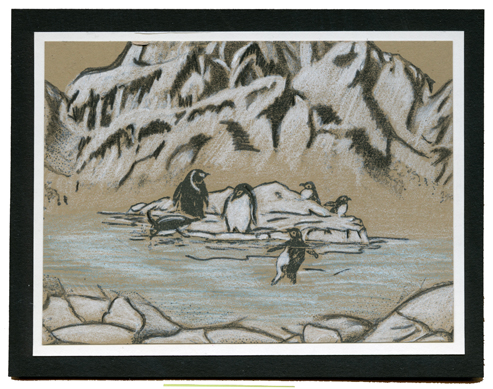
Brown bagging your lunch is a great way to save money—and if you make it yourself, you always know what’s being served. Four of the beautiful, earth-toned cards shown here, created by Tonya Weakley, were done on 80 lb. cardstock similar to the brown paper most everyone knows as Kraft paper.
Weakly says that the cardstock with its hard, uncoated and smooth finish, produces much better results than the “rougher, fibrous paper,” but her artistic techniques will work on a variety of surfaces.
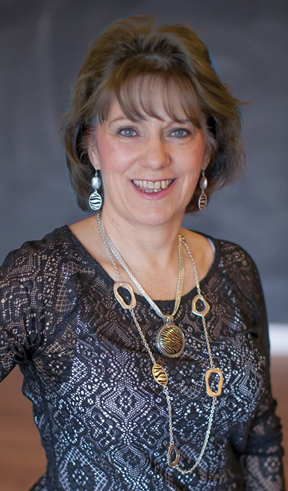
The artist
Primarily a self-taught artist, Weakley became a cooperative owner of a small art gallery during the early 1980s where she sold her framed artwork and gave lessons in drawing. She currently lives in Somonauk, Illinois, where she’s proprietor of a commercial print shop.
One day, in the early 1990s, a woman entered the shop asking for rubber stamps. “What kind of stamp do you need?” Weakley asked the woman. “An endorsement stamp? Return address stamp? ”This was Weakley’s introduction to rubber stamps and what eventually motivated her to explore the artistic medium.
By the mid-’90s, and a few years after she began selling rubber stamps in the print shop, Weakley opened a rubber stamp and scrapbook store called Peddlers Den in the neighboring town of Sandwich. “Both are small rural towns in north-central Illinois, about 60 miles west of Chicago in the middle of corn fields.”
Initially, the shop served as a crafters’ mall where artisans and crafters rented space to sell their wares. As vendors transitioned out of the mall, Weakley “chose not to re-rent the spaces,” until eventually the shop became solely her stamp and scrapbook store. With the roomier digs, Weakley began teaching workshops.
In addition to one-day classes, Weakley also offered three-day stamping retreats. “I had students from a dozen different states and as far away as Florida. It’s interesting that I attracted long distance students more frequently and more easily than local people.”
Teaching classes
As a businesswoman, Weakley makes time to serve as the vice president of the Sandwich Area Chamber of Commerce. She also serves on the board of directors for a non-profit foundation and coordinates fundraisers through the craft division of her company as well as her direct jewelry sales outlet. “I love helping groups and organizations raise much needed funds,” she says.
Weakley made a life and business change recently. She closed her brick-and-mortar store in Sandwich and has joined with other artists sharing space in a renovated foundry building in Plano. Describing it as a “specialty shop mall,” this location includes six rooms plus a large, shared area. There’s even an on-site coffee bar. Weakley will offer basic classes here, although advanced classes will be held at the Peddlers Den Event Center in Somonaulk.
What works well in the new location is the fact two people can share sales for all tenants, allowing artists more time to work at home or explore other activities.
“Most of my following is scattered all over the U.S.A. and it’s become more and more cost-prohibitive for them to come to my classes and retreats.”
As a result, the artist’s goal is to travel the nation as a freelance instructor and teach her classes and sell new art products at stamp stores and stamp clubs. She also plans to develop some online classes. “Since I love to travel, this may end up being a win-win option.”
Stores and stamp groups interested in having Weakley teach classes may contact her at (815) 498-3429 or visit www.peddlersden.com.
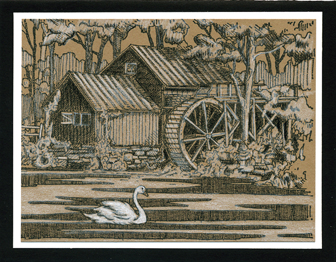
(Stamp credits: Mill pond scene—Impression Obsession.)
Paper, ink and pencils
Weakley began teaching the technique of using black-and-white pencils on Kraft paper more than 15 years ago. “In the past two years, this method has been far and away the most popular at the shows and events I’ve done. It’s extremely easy, fast, and requires little in terms of monetary investment or tools. Anyone can do it.”
When teaching workshops, Weakley advises her students to always test the inks and paper one intends to use because the result may be unexpected—an ink may bleed on one type of paper, but not another. “When I try a new brand of paper I test all my inks and the results are often amazingly different.”
Through experience Weakley discovered that Marvy Black ink produces an extremely black image on the Kraft paper she typically uses—the same ink turns gray on the semi-gloss paper she favors for scenic stamping, whereas StazOn and Memories inks are better suited for semi-gloss paper. The stamper advises that one should always allow the ink to thoroughly dry, because some inks will appear lighter once they have dried.
To create black-and-white scenes on brown Kraft paper, Weakley recommends using quality pencils with a soft pigment such as Prismacolor and Staedtler. The coverage is smooth and opaque, whereas lower grade pencils may have more transparency. The artist has also used quality watercolor pencils for this technique.
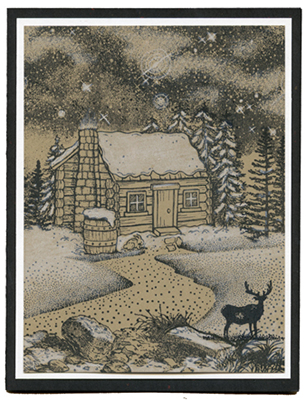
Winter Cabin / Tonya Weakley (Stamp credits: Sky, path, deer—Stampscapes, log cabin—Great Impressions, rocks—Beeswax.) 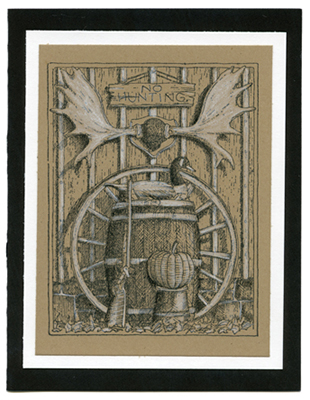
No Hunting / Tonya Weakley (Stamp credits: Wheel, wall and keg scene—Impression Obsession.)
Seeing in black and white
In one of Weakley’s beginner drawing classes she asks students to draw 10 boxes on white paper—the first box is colored the brightest white and the tenth box the darkest black. In between the white and black boxes are eight different shades of gray.
“The thing for beginners to understand is that the more values you create, the more beautiful the artwork will be,” explains Weakley. “You may not need 10 different values, but you should create a nice range to use in the stamped scenes.”
To create black-and-white scenes on Kraft paper, Weakley recommends stamping the images with black ink. Areas of the image or scene that are depicted as shadowed or dark should be darkened with a black pencil—a range of lighter values are created using the white pencil.
Three of the cards featured here were stamped using scenic images from Impression Obsession. “Many of their stamps by Gary Richardson lend themselves easily and well to this technique,” says Weakley. “They’re great for beginners who do not need to have any additional masking skills.”
Another distinct advantage of such images is that the shading on the images has already been determined—they are part of the rubber die. Typically, Weakley will darken “what is already there” in the image or “close up” hatch marks to make an image appear more solid and a deeper black.
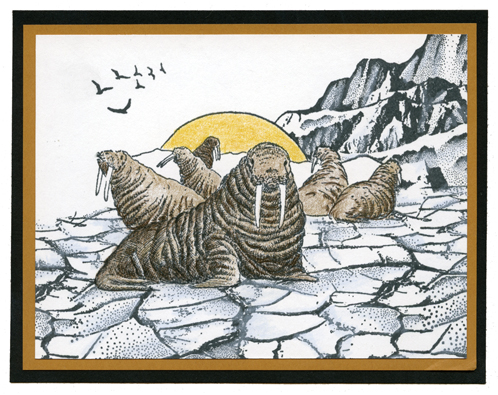
(Stamp credits: Walrus—Impression Obsessions, earth/ice, peaks, seagulls—Stampscapes.)
Walrus Beach
Although Walrus Beach is not an example of stamping on Kraft paper, the coloring techniques are similar. Weakley stamped the tall peaks in gray ink because the lighter value makes them effectively recede into the background. If Kraft paper had been used, the peaks could easily be lightened with a white pencil.
Some of the darker areas in the cracked ice and peaks were darkened “very sparingly” using black pencil. To add more depth and value to the fleshy walruses, a black pencil was used to darken all of the deep creases and folds in their skin.
Replicating a sepia tone using this technique is also possible. Weakley advises using a lighter color cardstock—such as a beige hue—and to stamp the images in dark brown ink and color them with a variety of hues in brown and white. “Occasionally I use some other colors of pencils, like the blue with the penguins or yellow in the walrus scene, but these are never my favorites. I like the monochromatic scenes.”

